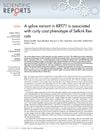The Expression of Equine Keratins K42 and K124 Is Restricted to the Hoof Epidermal Lamellae of Equus Caballus
September 2019
in “
PLoS ONE
”
TLDR K42 and K124 keratins are only found in horse hoof lamellae.
The study investigated the expression of equine keratins K42 and K124, finding that these keratins were specifically localized to the hoof epidermal lamellae of horses and not present in other tissues. Using techniques such as RT-PCR, in situ hybridization, and immunoblotting, the research confirmed that K124 was primarily expressed in the suprabasal layers of the lamellae, while KRT14 was restricted to basal cells. Monoclonal antibodies developed against K124 showed no cross-reactivity with other tissues, confirming its specificity. The study involved samples from 18 horses, providing a robust dataset. The findings suggested that K42 and K124 played a crucial role in the hoof's mechanical properties and could serve as biomarkers for equine laminitis, offering insights into the specialization of keratin isoforms in equine hoof tissue.




